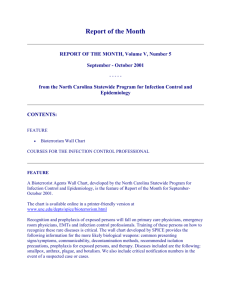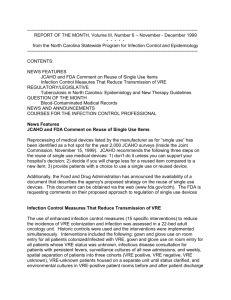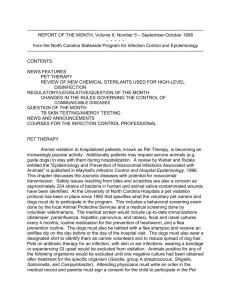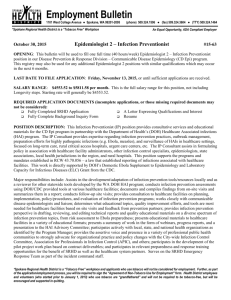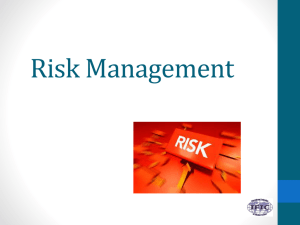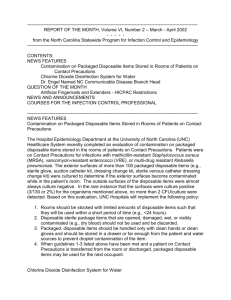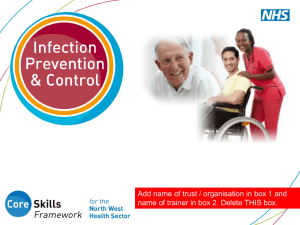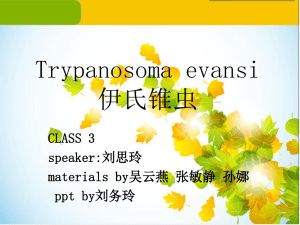STATEWIDE INFECTION CONTROL PROGRAM - SPICE
advertisement
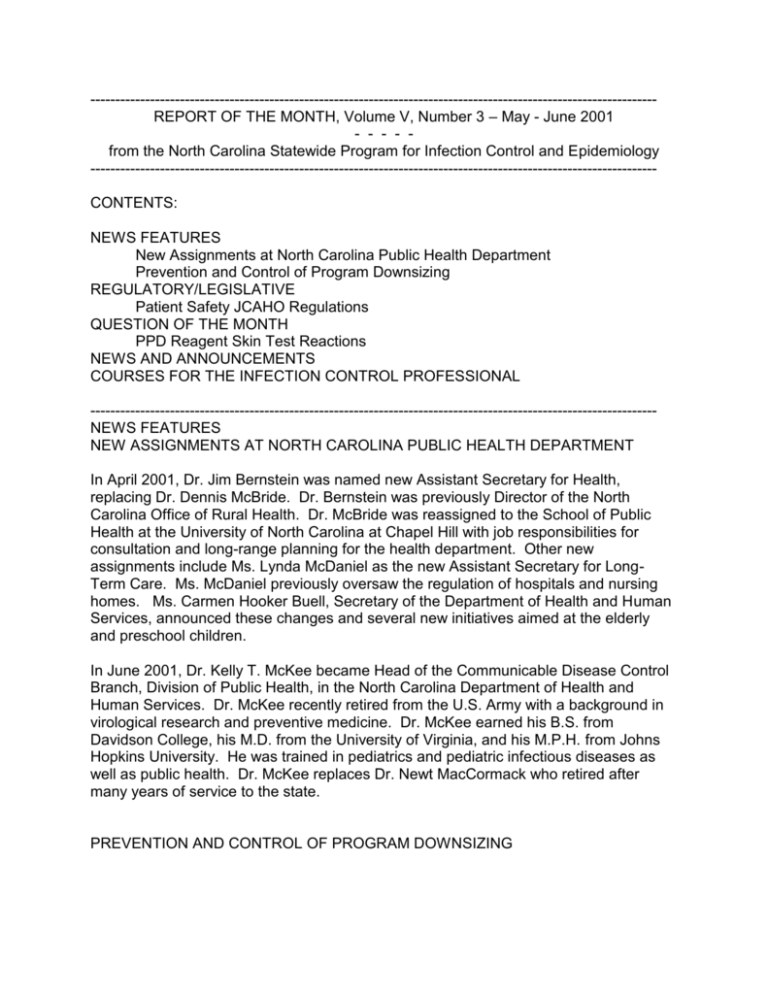
-----------------------------------------------------------------------------------------------------------------REPORT OF THE MONTH, Volume V, Number 3 – May - June 2001 - - - - from the North Carolina Statewide Program for Infection Control and Epidemiology -----------------------------------------------------------------------------------------------------------------CONTENTS: NEWS FEATURES New Assignments at North Carolina Public Health Department Prevention and Control of Program Downsizing REGULATORY/LEGISLATIVE Patient Safety JCAHO Regulations QUESTION OF THE MONTH PPD Reagent Skin Test Reactions NEWS AND ANNOUNCEMENTS COURSES FOR THE INFECTION CONTROL PROFESSIONAL -----------------------------------------------------------------------------------------------------------------NEWS FEATURES NEW ASSIGNMENTS AT NORTH CAROLINA PUBLIC HEALTH DEPARTMENT In April 2001, Dr. Jim Bernstein was named new Assistant Secretary for Health, replacing Dr. Dennis McBride. Dr. Bernstein was previously Director of the North Carolina Office of Rural Health. Dr. McBride was reassigned to the School of Public Health at the University of North Carolina at Chapel Hill with job responsibilities for consultation and long-range planning for the health department. Other new assignments include Ms. Lynda McDaniel as the new Assistant Secretary for LongTerm Care. Ms. McDaniel previously oversaw the regulation of hospitals and nursing homes. Ms. Carmen Hooker Buell, Secretary of the Department of Health and Human Services, announced these changes and several new initiatives aimed at the elderly and preschool children. In June 2001, Dr. Kelly T. McKee became Head of the Communicable Disease Control Branch, Division of Public Health, in the North Carolina Department of Health and Human Services. Dr. McKee recently retired from the U.S. Army with a background in virological research and preventive medicine. Dr. McKee earned his B.S. from Davidson College, his M.D. from the University of Virginia, and his M.P.H. from Johns Hopkins University. He was trained in pediatrics and pediatric infectious diseases as well as public health. Dr. McKee replaces Dr. Newt MacCormack who retired after many years of service to the state. PREVENTION AND CONTROL OF PROGRAM DOWNSIZING Downsizing has happened to many infection control programs around the country. While at the same time, programs are facing increasing responsibilities for implementing new regulatory standards, guidelines and education. David Calfee, MD, medical epidemiologist, reported on such an experience in the year 2000 at the annual meeting of the Society for Healthcare Epidemiology of America (SHEA) in Toronto. When cost-cutting consultants were brought to the University of Virginia (UVA) Health System and recommended a 50% resource reduction in the infection control programs, hospital epidemiology organized its own comparison. The proposed cuts were based on an email survey of nine hospitals of similar size and complexity. Information collected from these infection control programs (many recently downsized by costcutting consultants) revealed none were doing the same intensity of surveillance for nosocomial infections in general or doing pro-active identification and isolation of methicillin-resistant Staphylococcus aureus (MRSA) and vancomycin-resistant enterococci (VRE) colonized or infected patients. The data collected on the number of nosocomial bacteremias associated with MRSA and VRE from some of the other hospitals could be compared with the data from UVA. The hospitals with small infection control programs reported rates of bacteremia that far exceeded those reported by UVA. Calfee and Farr calculated actual cost savings from lower bloodstream infections (BSI) rates based on previously published attributable costs of MRSA and VRE. The authors were able to give the hospital administration figures between $891,000 to $2.8 million saved annually by preventing the cost of BSI infections alone. The authors concluded, "Preventing infections is cost-effective. It is sometimes best to ignore consultants." Reference: Calfee D, Farr B. Infection control in the era of managed care. Abstract 127, Presented at the Society for Healthcare Epidemiology of America, Toronto, April 2001. REGULATORY/LEGISLATIVE PATIENT SAFETY JCAHO REGULATIONS On July 1, 2001, the JCAHO Patient Safety Standards take effect. Although there are a number of important components in the JCAHO new initiatives, one in particular is drawing considerable attention. This standard (RI.1.2.2.) indicates that: "The responsible licensed independent practitioner or his or her designee clearly explains the outcome of any treatments or procedures to the patient, and when appropriate, the family, when those outcomes differ significantly from the anticipated outcomes." The American Society for Healthcare Risk Management (ASHRM) responded by preparing a document, "Perspectives for Disclosure of Unanticipated Outcomes," designed to assist healthcare professionals in planning for policy and procedures to meet these new regulations. ASHRM believes that patients are entitled to information about outcomes of diagnostic tests, medical treatments, and surgical intervention, and that this perspective is the same whether the results are expected or unanticipated outcomes. The ASHRM paper recognized that there are many considerations to developing policy for disclosure of outcome information, particularly that involve negative or adverse events. Specific state-to-state legal variability, regulatory, institutional and cultural differences must be taken into consideration. Many healthcare providers have held the philosophy of "no harm, no foul"; that without evidence of damage there was no need to increase patient anxiety or create risk of liability by disclosing a system or human error. This philosophy will need scrutinizing with the new patient safety standards. For example, what would a facility disclose if a patient did not receive the prophylactic antibiotic Cefazolin within the time frame of 30 minutes prior to the surgical incision as recommended by the CDC guidelines? Should disclosure of the antibiotic error be made whether or not the patient had an unanticipated outcome of a post-operative surgical site infection? This issue will provide for much decision-making in healthcare facilities to be compliant with the new JCAHO standards. QUESTION OF THE MONTH PPD REAGENT SKIN TEST REACTIONS Q: The pharmacy at my facility changed from Tubersol for tuberculin skin testing (TST) to Aplisol to save money. Since then we have had several healthcare workers (HCWs) test positive as TST converters. I have heard that Aplisol has been identified as having false-positive results. But I need documentation in writing. A: Two different commercial tuberculin reagents are available in the United States. Villarino et al concluded that "both Aplisol (Parkdale Pharmaceuticals), and Tubersol (Connaught) will correctly classify comparable numbers of persons not infected with Mycobacterium tuberculosis and that the choice of product used for TST has little effect on test performance." However, a recent letter published in JAMA (June 7, 2000;283:2793) by Blumberg et al at the Grady Health System in Atlanta challenges that conclusion. The authors investigated a cluster of eleven healthcare workers with TST conversions after the facility changed from a 6-year prior use of Tubersol to Aplisol. All eleven HCWs who had tested as positive converters using Aplisol retested negative using Tubersol. These authors hypothesized that the difference in findings may reflect lot-to-lot variations of tuberculin in the reagent of Aplisol. They noted that Villarino in his study evaluated only two different lots of Aplisol PPD. Three other published studies have noted false-positive findings associated with Aplisol as compared to Tubersol for TST of their healthcare worker population. References: Villarino ME, et al, JAMA 1999;281:169-171; Blumberg HM, et al, Ann Intern Med 1995;122:658-663; Blackshear J, et al, Am Rev Respir Dis 1983;127:254; Shands JW, et al, Infect Control Hosp Epidemiol 1994;15:758-760; Rupp ME, et al, J Infect Dis 1994;169:1174-1175. NEWS AND ANNOUNCEMENTS Updated U.S. Public Health Service Guidelines for the Management of Occupational Exposures to HBV, HCV, and HIV and Recommendations for Postexposure Prophylaxis were published in the June 29, 2001 edition of the MMWR Recommendations and Reports and is available on the Internet. View this MMWR Recommendations and Reports at: http://www.cdc.gov/mmwr/preview/mmwrhtml/rr5011a1.htm or http://www.cdc.gov/mmwr/PDF/rr/rr5011.pdf . On May 11, the US Food and Drug Administration approved a new combination vaccine that protects individuals 18 years of age or older against diseases caused by the hepatitis A virus (HAV) and the hepatitis B virus (HBV). The vaccine, called Twinrix, combines two already approved vaccines. The Certification Board of Infection Control and Epidemiology, Inc. (CBIC) executive office has moved to 1275 K Street, NW, Suite 1000, Washington, DC 20005-4006. The phone number is 202-454-2550 and the Fax number is 202-789-1899. The web site remains www.cbic.org. The APIC-NC Summer Meeting is August 3, 2001 at FirstHealth Moore Regional Hospital, Pinehurst, NC. APIC-NC/Palmetto Fall Conference is October 14-17, 2001 at the Joseph S. Koury Convention Center, Sheraton Four Seasons, Greensboro, NC. For Information about these two meetings: registration - Doug Williams email: yanc1@skantech.net; and program - Kathy Butler Lockamy email: kbutler@capefearvalley.com COURSES FOR THE INFECTION CONTROL PROFESSIONAL "Infection Control Part II: The ICP as an Environmentalist" will be held September 1014, 2001 at the Holiday Inn in Chapel Hill. "Infection Control in Home Health and Hospice" will be held October 8, 2001 at The Friday Center in Chapel Hill. -----------------------------------------------------------------------------------------------------------------Contributors to Report of the Month: Karen K. Hoffmann, RN, MS, CIC; William A. Rutala, PhD, MPH; David J. Weber, MD, MPH; Eva P. Clontz, MEd. -----------------------------------------------------------------------------------------------------------------To subscribe to the Report of the Month, send email to spice@unc.edu Report of the Month is also available on the home page of the Statewide Program for Infection Control and Epidemiology at http://www.unc.edu/depts/spice/ The Statewide Program for Infection Control and Epidemiology (SPICE) is funded by the General Assembly of North Carolina to serve the State. SPICE is not a regulatory agency but provides education and consultation to North Carolina healthcare facilities. Copyright 2001 Statewide Program for Infection Control and Epidemiology
